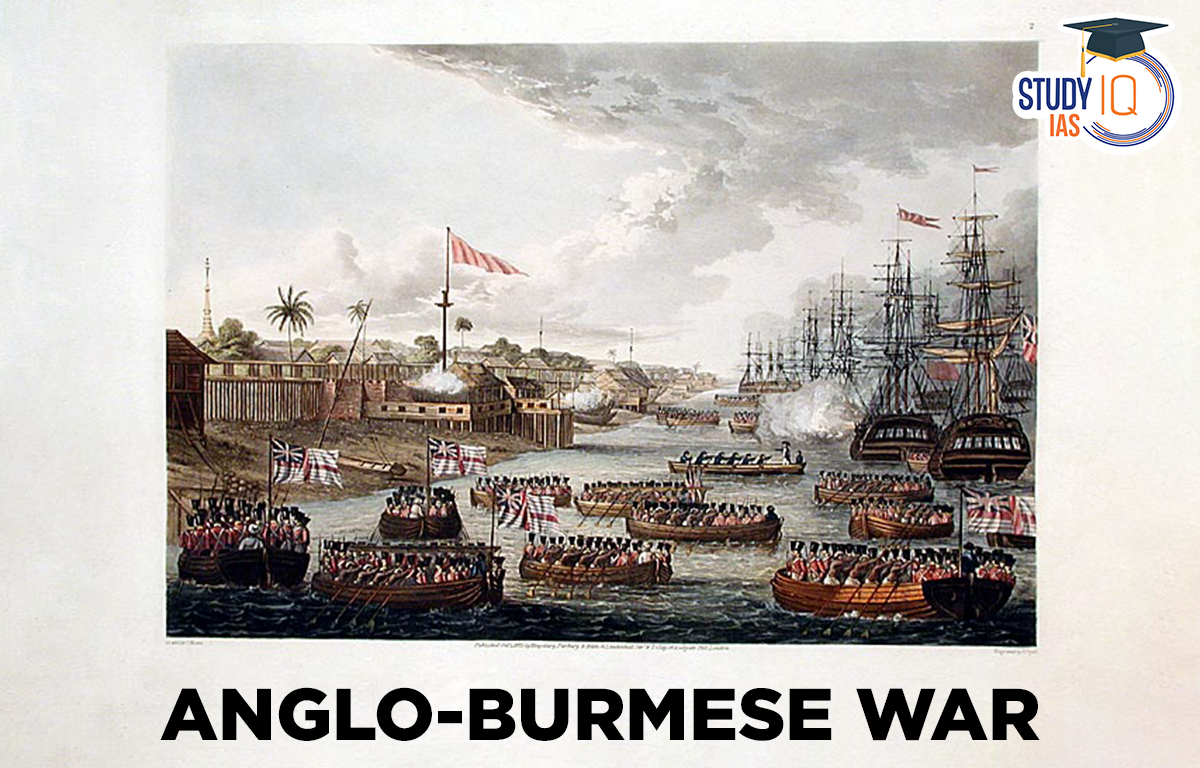Table of Contents
Anglo-Burmese War
Read all about Anglo-Burmese War. The conflict was started by border conflicts between British India and Burma. It was ignored by the expansionist tendencies. The abundance of forests in Burma made British traders envy, and they were anxious to encourage the export of their manufactured goods to the country’s citizens. The expansion of French political and commercial dominance in Burma and Southeast Asia also worried the British authorities. In three separate conflicts throughout the course of the nineteenth century, the British ultimately defeated the independent kingdom of Burma. This article has all the details related to Anglo-Burmese War for UPSC Exam Preparations.
Read about: Anglo-Mysore War
Anglo-Burmese War History
Between 1824 and 1885, British India and the monarchs of Burma engaged in numerous wars, which led to the establishment of British dominance over Burma in 1886. The Anglo-Burma War began with the first Anglo-Burmese War.
From 1752 to 1885, the Konbaung Dynasty ruled over Burma (modern-day Myanmar). In the years 1765–1769, the Konbaung Dynasty attempted to invade and conquer Siam (Ayutthaya Kingdom), present-day Thailand. China was begged for assistance by the Ayutthaya Kingdom, and the Qing Dynasty fought a battle against the tyrannical Burmese rulers.
Read about: Anglo-Maratha War
First Burmese War
When both nations were growing at the end of the 18th century, Burma and British India shared a boundary. After centuries of internal struggle, King Alaungpaya united Burma between 1752 and 1760.
King Alaungpaya’s successor, Bodawpaya, established Burma’s border with British India by establishing his capital in Ava on the Irrawaddi River, repeatedly invading Siam, repelling numerous Chinese incursions, and capturing the Border States of Arakan (1785) and Manipur (1813). He kept moving west and posed a threat to Assam and the Brahmaputra Valley.
The Burmese took control of Assam in 1822. There have been continual conflicts along the ill-defined boundary between Bengal and Burma since the Burmese took control of Arakan and Assam. The Arakanese fugitives were pursued by the Burmese government, which exerted pressure on the British administration to pursue them and turn them over to Burmese authorities.
Read about: Carnatic War
First Anglo-Burmese War Causes
After failing in Thailand, Burma turned its attention to the Arakan region in the west (Present day Manipur area). Since the Mughal era, Bengal’s eastern frontier, the Arakan, has been largely independent. King Bodawpaya of Burma’s armies invaded Arakan in 1813, taking modern Manipur as well as Assam in 1817–18. As the British now approached the Bengali border, the Burma Kingdom came face to face with them.
British India and Burma frequently clashed because the border between them was unclear and because both countries had an expansionist outlook. Both parties used the border dispute as an excuse for their expansionist goals, which resulted in the First Anglo-Burmese War.
Read about: Battle of Buxar
Treaty of Yandabo
In February 1826, the two sides signed the Yandabo Treaty. All of Burma’s claims to Assam, Cachar, and Jaintia were renounced. It gave the English control of Arakan, Yeh, Tavoy, Mergui, and Tenasserim. It consented to recognize Gambhir Singh as Manipur’s monarch and acknowledged the state of Manipur as an independent nation.
It consented to provide the English a war indemnity of Rs. 1.5 crore. In addition to agreeing to depute and welcome each other’s ambassadors as well as to enter into a business contract, both parties accepted each other as friends.
Read about: Battle of Plassey
Second Anglo-Burmese war
In February 1826, the two sides signed the Yandabo Treaty. All of Burma’s claims to Assam, Cachar, and Jaintia were renounced. It gave the English control of Arakan, Yeh, Tavoy, Mergui, and Tenasserim. It consented to recognise Gambhir Singh as Manipur’s monarch and acknowledged the state of Manipur as an independent nation.
It consented to provide the English a war indemnity of Rs. 1.5 crore. In addition to agreeing to depute and welcome each other’s ambassadors as well as to enter into a business contract, both parties accepted each other as friends.
In addition, there were a few minor bilateral concerns with the Treaty of Yandabu. But it was never made known precisely under what conditions this war was fought. On April 5, 1852, the war officially began, and the next day, Martaban’s harbour was captured. Rangoon was annexed on April 12 and seized by Pegu in June. A proclamation of annexation was read out in January 1853, ending the conflict without a treaty being signed. As a result of this conflict, Pegu was renamed Lower Burma and ceded to the British Empire. From Chittagong in the east to Singapore, there was now British sovereignty.
Read about: Partition of Bengal
Second Anglo-Burmese war Causes
Lord Dalhousie was able to significantly alter the layout of British India. He was the one who started the Second Anglo-Burmese War against Burma, and his only motivation was to keep other European nations out of Burma and increase the size of the British Empire. The acquisition of Punjab marked the end of the second Anglo-Sikh war.
These two annexations were done using proclamations rather than a treaty. Lord Dalhousie reduced the Punjab and established the British standard in Peshawar before getting involved with the Burmese administration, which had always been stubborn and reckless when dealing with foreigners like Chinese and British.
When the First Anglo-Burmese War broke out in 1826, the Burmese had no idea that they were essentially at the mercy of a powerful marine force in the Bay of Bengal that might seize their whole coastline and advance as far as the Irawadi River. The second Anglo-Burmese War, which ended with the official proclamation of annexation of Lower Burma (Pegu) on December 20, 1852, was the only time the overly clever rulers of Burma could comprehend the military superiority of Britain.
Following this conquest, the British Possessions extended from Chittagong all the way to Singapore along the Eastern Shores of the Bay of Bengal. The British colony in Calcutta served as a springboard for the invasion of Burma, and the first stage was the establishment of Rangoon as the capital of British Possessions along the Irawadi River.
Read about: Revolt of 1857
Third Anglo-Burmese War
French involvement in Indo-China produced turbulence on the eastern front, which prompted the British to meddle in independent Burma’s internal affairs. It was said that the Kind Thebau consistently mistreated the British subjects. Due to a succession issue, a British resident was expelled from Burma. As a result, upper Burma was invaded by a force led by General Harry North Dalrymple Prendergast. The King gave up in two weeks and was taken prisoner to Madras.
Read about: Indigo Revolt
Third Anglo-Burmese War Causes
Lower Burma was annexed as a province of British India on September 25, 1886, while the lands of Burma were annexed on January 1 of that year. Sir Charles Bernard served as the first chief commissioner.
Thus, imperialism, not justice, was to blame for this annexation. But the Burmese people were outraged by this annexation. They began waging protracted guerilla warfare in their quest for independence. These guerilla fighters were brutally crushed after a series of costly battles were launched against them. But even in India, this annexation was unwelcome. This was a result of the higher costs that would now be borne by Indian subjects. Indians prayed for Burma to become a crown colony like Ceylon.
Read about: Civil Disobedience Movement


 Maharashtra’s Mendrachi Vancharai Syst...
Maharashtra’s Mendrachi Vancharai Syst...
 Keeladi Excavation: Uncovering the Ancie...
Keeladi Excavation: Uncovering the Ancie...
 Sanyasi Revolt, Objectives, History, Rea...
Sanyasi Revolt, Objectives, History, Rea...





















